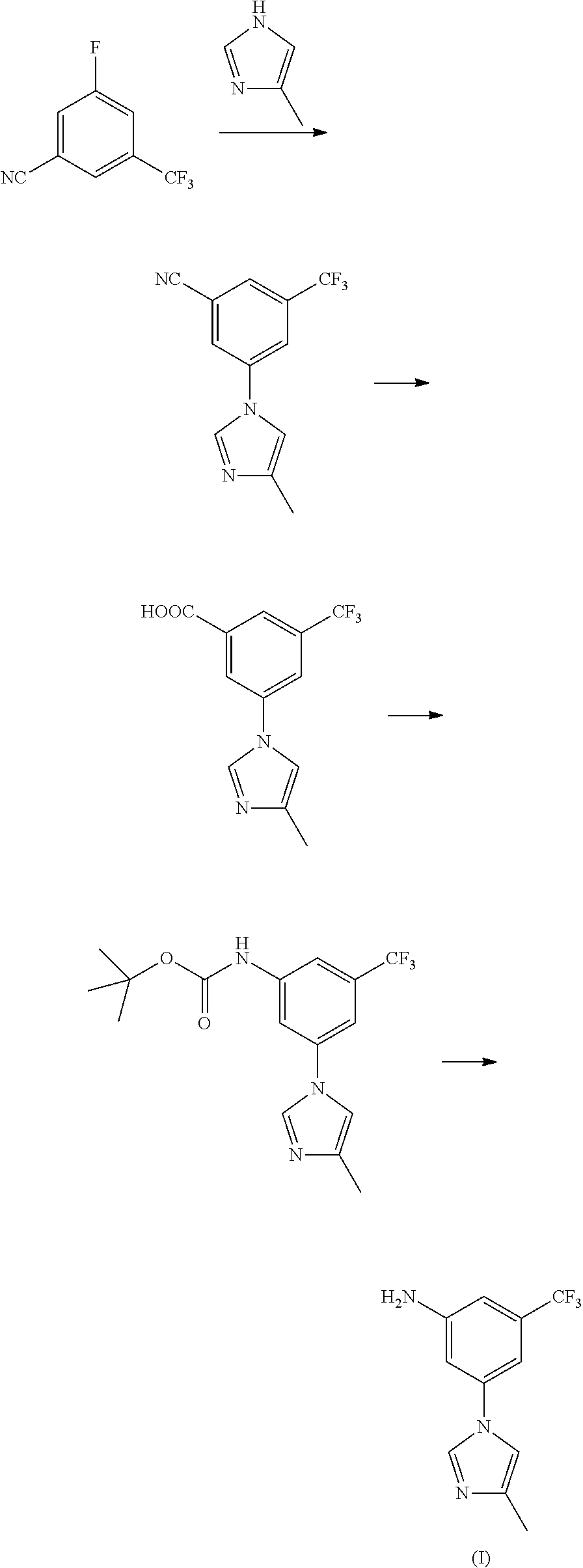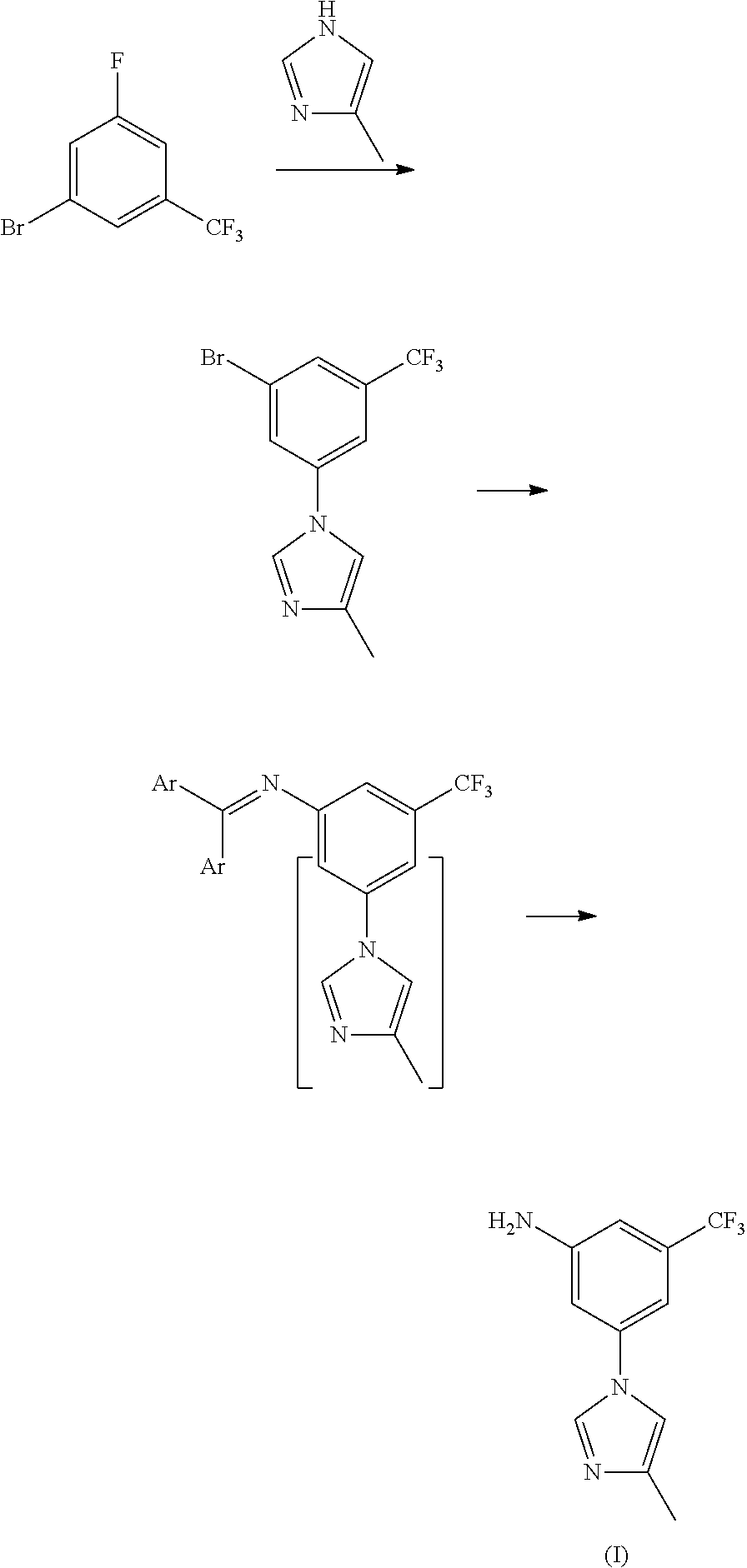Method for preparing nilotinib intermediate
a technology of nilotinib and intermediate, applied in the field of method for preparing nilotinib intermediate, can solve the problems of high cost and low yield, long steps, rare raw materials, etc., and achieve the effects of easy operation, low cost and low yield
- Summary
- Abstract
- Description
- Claims
- Application Information
AI Technical Summary
Benefits of technology
Problems solved by technology
Method used
Image
Examples
embodiment i
[0027]15 mL of concentrated nitric acid (60-65%) and 30 mL of concentrated sulfuric acid (98%) were mixed into mixed acid at 0-10° C., added dropwise 29.2 g of trifluorotoluene (29.2 g, 0.2 mol) at 0-5° C., reacted for 8 hours at room temperature, to complete the reaction detected by TLC. Poured the reaction solution into ice water, extracted with ethyl acetate, washed with 10% sodium hydroxide, and dried, the solvent was removed under a reduced pressure condition, to get 34.0 g of light yellow transparent liquid nitrobenzotrifluoride, with a yield of 89.0%, boiling point 105-107° C. (4 kPa), and the next reaction can be started with no need for purification.
embodiment ii
[0028]Under 100 mL concentrated sulfuric acid ice-water bath, added 19.1 g (0.1 mol) of nitrobenzotrifluoride, added dropwise liquid bromine (15.8 g, 0.1 mol) by batch at room temperature, controlled the reaction temperature at 60-70° C. to react for 14 hours, to complete the reaction detected by TLC. Leaved it standstill for layering, washed the organic phases with 5% sodium hydroxide and saturated salt water, concentrated, to get 24.7 g of orange red oily matter 3-bromo-5-nitro-trifluorotoluene, with a yield of 91.8%, boiling point 74-76° C. (70 Pa); EI-MS (m / z): 269(M+H); 1H NMR (400 MHz, CDCl3) δ 8.59-8.60(m, 1H), 8.46(m, 1H), 8.12(m, 1H).
embodiment iii
[0029]13.5 g of 3-bromo-5-nitro-trifluorotoluene (13.5 g, 0.05 mol), 5.0 g of 4-methyl-1H-imidazole (5.0 g, 0.06 mol), 1.42 g of cuprous iodide (1.42 g, 7.5 mmol), 2.2 g of 8-hydroxyisoquinoline (2.2 g, 7.5 mmol), 7.6 g of potassium carbonate (0.055 mol) and 50 mL of N,N-dimethylformamide were added to a 250 mL three-necked bottle, heated to 100° C., stirred to dissolve. Added with 0.75 g of triethylamine (0.75 g, 7.5 mmol), continued to heat to 140° C., reacted for 5 hours, to complete the reaction detected by TLC. Cooled down to 50-60° C., filtered, and the filter cake was washed with ethyl acetate, the filter liquor was washed with saline water and water, concentrated, then recrystallized by ethyl acetate and n-hexane (1:1), to get 10.6 g of yellow solid 3-(4-methyl-1H-imidazol-1-yl)-5-nitro-trifluorotoluene, with a yield of 78.2%, melting point 118-120° C., MS-ESI (m / z): 272(M+H), 1H NMR (400 MHz, CDCl3) δ 8.45(s, 2H), 7.95(s, 1H), 7.93(s, 1H), 7.16(s, 1H), 2.33(s, 3H).
PUM
| Property | Measurement | Unit |
|---|---|---|
| temperature | aaaaa | aaaaa |
| temperature | aaaaa | aaaaa |
| temperature | aaaaa | aaaaa |
Abstract
Description
Claims
Application Information
 Login to View More
Login to View More - R&D
- Intellectual Property
- Life Sciences
- Materials
- Tech Scout
- Unparalleled Data Quality
- Higher Quality Content
- 60% Fewer Hallucinations
Browse by: Latest US Patents, China's latest patents, Technical Efficacy Thesaurus, Application Domain, Technology Topic, Popular Technical Reports.
© 2025 PatSnap. All rights reserved.Legal|Privacy policy|Modern Slavery Act Transparency Statement|Sitemap|About US| Contact US: help@patsnap.com



